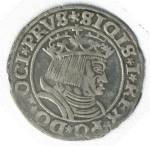Sigismund I of Poland
|
|
| Zygmunt I Stary | |
|
| |
| Reign | From December 8 1506 until April 1, 1548 |
| Coronation | On January 24 1507 in the Wawel Cathedral, Kraków, Poland |
| Royal House | Jagiellon |
| Parents | Kazimierz IV Jagiellończyk Elżbieta Rakuszanka |
| Consorts | Katarzyna Telniczanka Barbara Zapolya Bona Sforza |
| Children | with Katarzyna Telniczanka Jan Regina Katarzyna with Barbara Zapolya Jadwiga Anna with Bona Sforza Izabela Jagiellonka Zygmunt II August Zofia Anna Jagiellonka Katarzyna Jagiellonka Olbracht (Wojciech) |
| Date of Birth | January 1, 1467 |
| Place of Birth | Kozinice, Poland |
| Date of Death | April 1, 1548 |
| Place of Death | Kraków, Poland |
| Place of Burial | Wawel Cathedral, Kraków, Poland buried on July 26, 1548 |
Sigismund I the Old (1467-1548), Polish: Zygmunt I Stary, fifth ruler of the Jagiellonian dynasty, reigned as king of Poland from 1506 until his death.
Before Sigismund I ruled as King of Poland and Grand Prince of Lithuania 1505 – 1548, he had already been invested as duke of Silesia.
The son of king Casimir IV of Poland and Elizabeth of Austria, Sigismund followed his brothers John Albert and Alexander on the Polish throne. Their eldest brother Wladislaus became the king of Hungary and Bohemia.
He was christened as namesake of his mother's maternal grandfather, Emperor Sigismund, who had died in 1437.
Sigismund faced the challenge of consolidating internal power to face external threats to the country. During Alexander's rule, a law "Nihil novi" had been instated, that forbade Kings of Poland from enacting laws without the consent of the sejm. This proved crippling in Sigismund's dealings with his szlachta and magnates.
Despite this Achilles heel, he established (1527) a conscription army, and the bureaucracy necessary to finance it.
Intermittently at war with Vasily III of Muscovy, starting in 1507 (before his army was fully under his command), 1514 marked the fall of Smolensk (under Polish domination) to the Muscovite forces (which lent force to his arguments for the necessity of a standing army). 1515 he entered an alliance with the Holy Roman Emperor Maximilian I.
In return for Maximilian lending weight to the provisions of the 2nd Peace of Thorn, Sigismund consented to the marriage of the children of Vladislaus II of Bohemia and Hungary, his brother, to the grandchildren of Maximilian. Through this double marriage contract, Bohemia and Hungary passed to the House of Habsburg in 1526, on the death of Sigismund's nephew, Louis II.
Prussian_Homage.JPG
The Polish wars against the Teutonic Knights ended in 1525, when Albert of Brandenburg, their marshal (and Sigismund's nephew), converted to Lutheranism, secularized the order, and paid homage to Sigismund, who in return gave him the domains of that order, as the First Duke of Prussia. This was called the Prussian Tribute. Sigismund I's eldest daughter Jadwiga (1513-1573) married Elector Joachim II of Brandenburg.
In other politics, Sigismund sought a peaceful coexistence with the Khans of Crimea, but was unable to completely end border skirmishes.
Sigismund was a Humanist (c.f. David Hume). He and his 2nd wife, Bona Sforza, daughter of Gian Galeazzo Sforza of Milan, were both patrons of Renaissance culture, which began, under them, to flourish in Poland.
On Sigismund's death, his son Sigismund Augustus became the last Jagiellonian king of Poland.
See also
- Bell of Sigismund (Dzwon Zygmunta)
| Preceded by: Alexander | King of Poland 1506–1548 | Succeeded by: Sigismund II Template:End boxde:Sigismund I. (Polen) et:Zygmunt I ja:ズィグムント1世 (ポーランド王) pl:Zygmunt I Stary ru:Сигизмунд I sv:Sigismund I av Polen |

